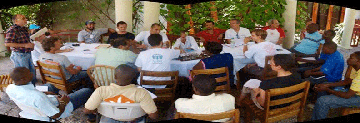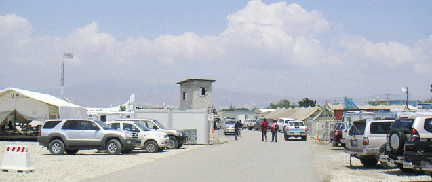The "Cluster" System in Haiti
When there is a humanitarian disaster, the UN activates the “clusters” or groupings of “UN agencies, non-governmental organizations (NGOs) and other international organizations around a sector or service provided during a humanitarian crisis,” according to the website for the UN Integrated Mission to Timor-Leste.
The Cluster System was implemented beginning in 2009 by the UN’s Inter-Agency Standing Committee (IASC), a UN coordination mechanism. In Haiti there are 12 Clusters which have about 40 to 60 agencies and NGOs in them. [Page with links to all Clusters]
Immediately following January 12, there were up to 70 or 80 Cluster meetings a week, many or all at the U.N. “Logistics Base” or “Log Base” near the airport. Now there are 40 to 50, mostly at the city and town level, with a national meeting once a week or once every two weeks. [Eg.: Meetings week of Oct 11-15]

Shelter Cluster meeting, from Shelter Cluster website
While the Cluster coordinator is always from a large NGO or multilateral agency, as the emergency phase subsides, local government ministries and agencies are supposed to take over leadership, so they can coordinate and eventually direct the intenational agencies and NGOs.
But in Haiti “that has not been the case,” according to Jolanda van Dijk, an "Inter-Cluster Coordinator" who works for the Office of Humanitarian Affaires, OCHA.
Instead, at the national level at least, the Haitian government has been slow to integrate the process.
Sometimes that is because there is not a clear Haitian counterpart to a Cluster’s focus. For example, while the Ministry of Social Affairs does have a small housing agency, there is no “Ministry of Housing.” Nor is there a clear ministry that could step into the “Camp Coordination and Camp Management” Cluster focus.
Van Dijk said the Clusters also share part of the blame.
“A couple of months into the disaster, we realized that Log Base is like an island. It is very far, it’s very isolated,” she said.
UN soldiers also restrict access and Haitians reported regularly being turned away.

A view of Logbase
Now, many Clusters hold meetings at the municipal level, but a review of meeting minutes posted online, and investigations in the field indicate that for most Clusters, the ministries or national agencies are not yet in charge.
The exception is the Water Sanitation and Hygeine (WASH) Cluster, held up by all – van Dijk, Cluster staff and Haitians who know about it – to be “the best” Cluster.Meetings are coordinated by a staffer from the National Directorate for Water Supply and Sanitation (DINEPA) and they are held in the relevant city or town.
But in general, the transition over to ministries has been much slower in Haiti than than in other countries, van Dijk said.
One reason is magnitude of the catastrophe and the fact that “seven of 11 ministries collapsed,” she noted.
But another might be the fact that many meetings are still held in English and at the Logbase, according to Pierre Gary Mathieru, director of the National Coordination for Food Security, which is part of the Ministry of Agriculture. Many of the documents produced by the Clusters are also in English only.
“I won’t go to meetings anymore because I am in Haiti, and I can’t accept that foreigners are coordinating the Clusters,” Mathieu told Haiti Grassroots Watch.
Mathieu agreed that the government didn’t have the capacity to coordinate all the agencies and NGOs right after the earthquake. But now, he said, “it’s time for the government to take charge… Strategic decisions should be made by the state, and then the NGOs can follow that strategy.”
Of course, the government needs to step up the plate also, Mathieu noted.
“Clusters are useful, they present people to share information,” he added. “But the national government needs to take over now.”
A recent memo that Haiti Grassroots Watch obtained indicates that there is some doubt the ministries are up to the task.
The document, titled "Draft Transitioning the clusters" and dated September 28 and apparently compiled or written by Inter-Cluster Coordinator Tania Bernath, who works with van Dijk, runs through the 12 Clusters and makes assessments of the involvement of the relevant government ministry or agency.
The government seems to have a “lack of understanding of cluster system across most clusters,” the document notes and adds that there are “many examples of lack of coordination among and between government at different levels…”
Regarding the Protection Cluster, which is related to human rights, there is “very little interaction with government structures.”’
And related to the Camp Coordination and Camp Management Cluster (CCCM), there is a “lack of national governmental involvement in cluster,” the document notes.
Van Dijk said she and other Cluster staff know that the inclusion and eventual hand-off of the Clusters to the relevant national agencies is important.
“We very much want the Haitian government to be involved,” she said.
The weeks and months ahead will tell if and how the planned integration and hand-off will take place.
Criticism from Mathieu and others echo earlier critiques which came from the very office that launched the Cluster System a year ago.
In its six-month report on the earthquake response, the IASC criticized the agencies and the NGOs for their failure to include local authorities, noting that "the international humanitarian community’s engagement with Haitian civil society and local authorities, and their inclusion in common coordination mechanisms” could have been improved.
The report noted that if it “[h]ad this been achieved in a more systematic manner, it would have significantly improved the humanitarian community’s understanding of the operating context, and contributed to a more sustainable provision of assistance, as well as local and national capacity-building.” [Download the report]
Three months have gone by, but it appears as though the Clusters still have a way to go.
[For more constructive criticism, see the Global Public Policy Institute "real-time evaluation."]
Dossier #1 - WHAT IS THE PLAN FOR HAITI'S 1.3 MILLION HOMELESS?
Part 1 - Who is in charge and what is the plan?
Part 2 – What are the challenges?

